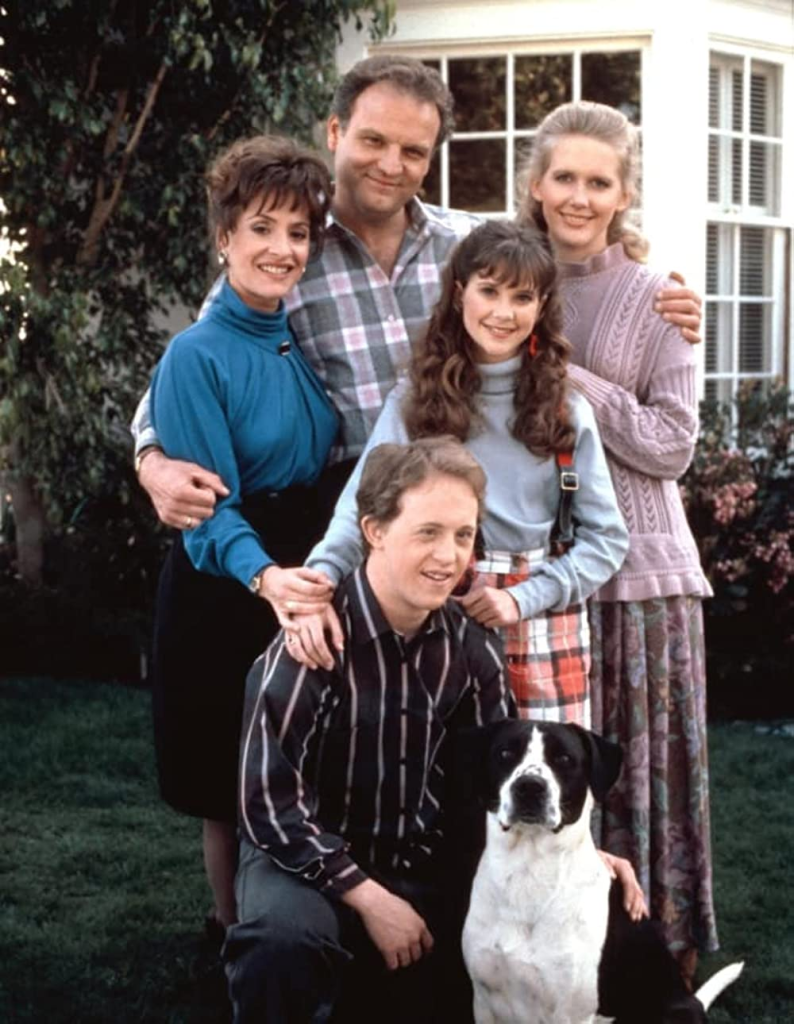As we are looking at some of our favorite television families, the series would not be coplete without the Tanners. Airing from 1987 to 1995, Full House appeared on ABC, producing 192 episodes. Jeff Franklin created the show about widower Danny Tanner (Bob Saget) who raised his three daughters: D.J. (Candace Cameron Bure), Stephanie (Jodi Sweetin), and Michelle (Mary Kate and Ashley Olsen) with the help of his brother-in-law Jesse (John Stamos) and best friend Joey (Dave Coulier). DJ’s best friend Kimmy (Andrea Barber) is also on the scene quite often. Interestingly, Coulier was friends with Saget and early in his career, he slept on Saget’s couch while he was trying to become a comedian.

Because Saget and Coulier were already friends, the two actors went on a road trip to Las Vegas with Stamos to help them get to know each other. Since Coulier and Stamos were both single at the time, they bonded a lot. On the show, Joey and Jesse also become closer friends, seeming to have more in common with each other than with Danny.
Danny is a sports anchor, his brother-in-law is a musician, and his best friend, a comedian. They juggle schedules to get the girls where they need to go and tuck them in at night.
In season two, Danny becomes the host of a morning show, Wake Up San Francisco. His costar, Rebecca (Lori Loughlin), is young and fun and smart. However, the romance is not between her and Danny; she dates and later marries Jesse.
Saget was always first choice for Danny but because of his schedule, the pilot features John Posey in the role. Jodi Sweetin was brought in after an appearance she made on Valerie. Loughlin was hired for a six-week limited romance but never left once she started.

There were a lot of famous celebrities who appeared on the show including Frankie Avalon, Scott Baio, The Beach Boys, Phyllis Diller, Annette Funicello, Kareem Abdul Jabaar, Little Richard, and Marcia Wallace. On one episode Cameron’s real brother, Kirk Cameron appeared with Chelsea Noble. They began dating and later married.
Surprisingly, the show’s writing staff was inconsistent; Franklin who also wrote for the show was the only writer to stay through eight seasons.
Several of the characters developed catch phrases that were repeated all over the country. Jesse’s was “Have Mercy”; Joey’s was “Cut it Out”; and D.J.’s was “Oh My Lanta.” Stephanie often said “How Rude” while Michelle fittingly had two (one for each twin), with “You Got it Dude” and “You’re in Big Trouble Mister.”

The theme song, “Everywhere You Look,” was co-written by Bennett Salvay and Jesse Frederick, with Frederick doing the singing.
The show was in the top thirty every year after season one. It was on Friday nights for most of its run. There was a short time during season two when it was briefly moved to Tuesdays and then aired on both Tuesdays and Fridays to try to build its audience numbers. During season five, the show moved to Tuesdays until it was canceled. Despite its being in the top 25 in 1995, the network decided to end the show. It cited increasing production costs.

Fun fact, Dave Coulier made a puppet for the show, Mr. Woodchuck. He sold it to Toys R Us if you are ever looking for a gift for a big fan of the show. Another interesting item is that Ashley Olsen was right-handed while Mary Kate was left-handed, so Michelle is ambidextrous.
Unlike so many of the reboots of shows from the 80s and 90s, this show had a sequel, Fuller House, starring the same cast from 2016-2020. The show recently began appearing in Me TV’s lineup of shows.
The cast was definitely one big family on the show and they considered themselves family off the air as well. This came to light recently after the death of Bob Saget. When asked about how they were doing, Coulier commented, “We pull together as a family during moments like this. We’ve pretty much experienced everything that a real family can experience. Getting picked up, getting canceled, marriages, divorces, births, deaths. I mean, it’s pretty much what every family goes through. And we’ve stuck together through all of it.”
He also said that it “was incredible to have a group of people in our lives like this, where we know we’re going to get that instant support system. It’s pretty special.” Bure said that the cast “genuinely love each other.”
Saget, Stamos, and Coulier truly watched the girls grow up and transition from their kids to their friends. It is these relationships that give the show the special heart-warming atmosphere that surrounds most of the scenes. There are the arguments, misunderstandings, and hurt feelings that all families experience, but there is also unconditional love both on and off the set. We would all be better off if we had a “Full House.”


















